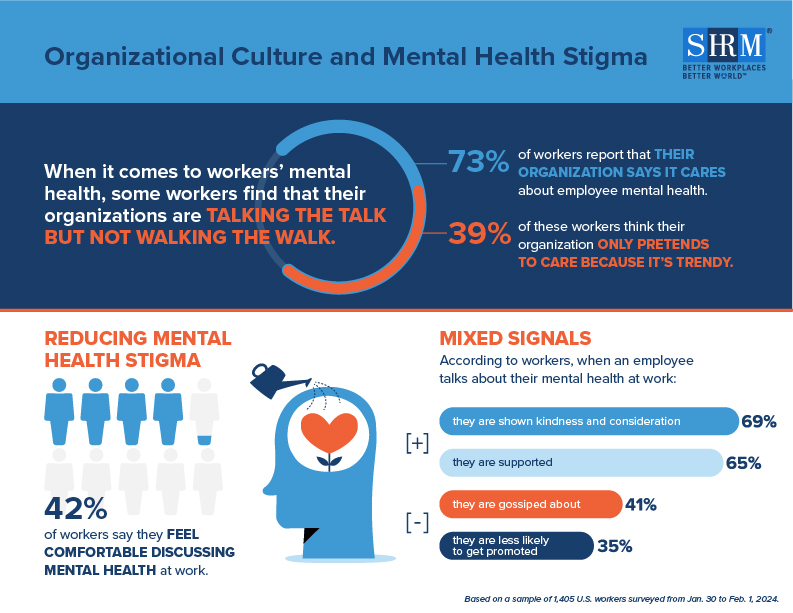Recent SHRM research shows that more than half of workers feel pressured to prioritize organizational well-being over their personal well-being, putting workers in difficult situations where they must decide between advancing their careers or protecting their personal well-being.
SHRM data found that this is especially true for women, who were equally or more likely than men to have encountered situations where they had to sacrifice their well-being to protect their jobs and advance their careers.
Employers can play a critical role in supporting the mental health of their workforce. Colleen Marshall, chief clinical officer at Two Chairs in San Francisco, has over two decades of executive leadership experience in behavioral health and behavior change service delivery.
Marshall spoke with SHRM Online about the state of mental health at work in the U.S., the dangers of burnout, and how companies can better support their employees’ mental health needs.
SHRM Online: From your vantage point, how would you describe the state of mental health in the workplace today?
Marshall: We are making progress. Employers and employees are seeking out mental health benefits for themselves and their employees, and we’re seeing more investment in different mental health offerings. However, we still have a way to go.
To have truly integrated mental health in organizations, there would be specific efforts to ensure employee wellness and mental health is a priority. This looks different for different people and different industries. It usually includes making sure the job itself is reasonable and manageable and that employees are able to manage their mental health the same way they can manage their physical health.
For instance, being able to have days off or being able to attend therapy appointments when needed is important. Also, having tools and groups that can help with employee wellness—such as mindfulness groups or having an onsite or easy-to-access mental health professional. These are measures that can help lower barriers to mental health care.
Ultimately, healthy employees are a win-win for the employee and the business.

SHRM Online: Reports show that burnout has become a significant issue at work, leading to increased absenteeism. What are some individual and organizational consequences of burnout?
Marshall: When organizations do not prioritize the wellness of their employees, burnout is real. So is the cost.
Often, employees simply leave, meaning the organization has the emotional and financial cost of having to replace and retrain the next person. Employees that stay aren’t doing their best work due to the emotional stress of burnout. They are also at risk of:
- Committing errors, both large and small.
- Low productivity.
- Safety concerns.
Burnout can also decrease engagement, which means the organization no longer has the full benefit and skill of that person. That person’s creativity, ideas, and energy to move forward initiatives decreases. The person suffers because they do not feel as fulfilled or successful—and the organization suffers, too.
There are a lot of things that can impact employees’ mental health. The job itself can be a factor. If the job is not manageable or reasonable, that can definitely lead to an employee feeling trapped and overwhelmed. An organization’s culture also has a direct impact on the employees’ mental health. If the organization is not supportive or [is] high in conflict, that can increase someone’s anxiety or depression, for instance.
Also, not having organizational behaviors that support mental health can impact the employee. For instance, if taking time off is not easy or judged, this can decrease employees’ desire to take time off, even though that could benefit their overall mental health and wellness.
SHRM Online: What are some simple ways for companies to better support workers’ mental health?
Marshall: It’s critical to ensure their employee benefits include mental health offerings that are discussed and publicly advertised so employees know it is available and how to access it.
In addition, leadership should communicate frequently and consistently that employee wellness and mental health are important to the organization. Specifically, share what your organization has in place now to support the employee. That could be telling employees how to use time off for mental health reasons or free resources that employees could access. It can be extremely helpful for leadership to model behaviors that support a culture of good mental health, such as being open about their own stories and setting a good example about work/life balance and taking paid time off.
One of the biggest barriers to good mental health is stigma. Although we have seen this abate in recent years, many people are still struggling with mental health challenges. Stigma is especially prevalent in the workplace due to people not knowing how or if it’s OK to talk about mental health with peers and superiors.
Employers are in a unique position to help reduce stigma even further through various channels. Some require investment, such as improved benefits, but others can be implemented with lower overhead, such as leadership behaviors, cultural shifts, and support groups for workers. Any and all of these send a signal to employees that their mental health is important.
Advertisement
An organization run by AI is not a futuristic concept. Such technology is already a part of many workplaces and will continue to shape the labor market and HR. Here's how employers and employees can successfully manage generative AI and other AI-powered systems.
Advertisement



